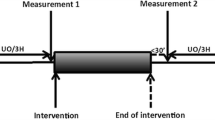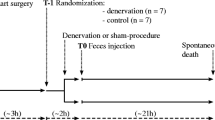Abstract
The physiologic effects of pulsatile and non-pulsatile flow in cardiopulmonary bypass were compared in terms of the relationship between different flow rates and what effects these had on pulsatile and non-pulsatile flow. Forty adult mongrel dogs were used in this study and divided into 5 groups, each comprised of 8 animals, according to the flow rate during cardiopulmonary bypass, namely; 40, 60, 80, 100, or 120 ml/kg/min. The animals were perfused with either pulsatile or non-pulsatile flow for 1 hour, given randomly at the same mean flow rate. At flow rates of 80 and 100 ml/kg/min, the mean arterial blood pressure and total peripheral vascular resistance were significantly lower in pulsatile flow than in non-pulsatile flow, and the renal blood flow was significantly greater in pulsatile flow than in non-pulsatile flow. The renal arterial-venous lactate difference was significantly less in pulsatile flow than in non-pulsatile flow at a flow rate of 80 ml/kg/min, and the renal lactate extraction was significantly higher in pulsatile flow than in non-pulsatile flow at the same flow rate. The renal excess lactate was significantly lower in pulsatile flow than in non-pulsatile flow at a flow rate of 100 ml/kg/min. There were no significant differences in these parameters between the two types of perfusion at flow rates of 40, 60 or 120 ml/kg/min. Pulsatile flow was therefore apparently advantageous, when compared to non-pulsatile flow, in terms of hemodynamics, renal circulation, and metabolism of the kidney at flow rates of 80 and 100 ml/kg/min. However, when the flow rate was 120 ml/kg/min, pulsatile flow and non-pulsatile flow had the same effects.
Similar content being viewed by others
References
Mandelbaum I, Burns WH. Pulsatile and non-pulsatile blood flow. JAMA 1965; 191: 657–660.
Takigawa Y. Significance of pulsatile flow to renal functions. Nippon Kyobu Geka Gakkai Zasshi (J Jpn Assoc Thorac Surg) 1971; 19: 46–62. (English Abst.)
Funami M, Takaba T, Ishii J. Experimental studies on the peripheral circulation and morphological changes during pulsatile and nonpulsatile cardiopulmonary bypass. Nippon Kyobu Geka Gakkai Zasshi (J Jpn Assoc Thorac Surg) 1981: 29: 1305–1315. (English Abst.)
Taylor KM, Bain WH, Russell M, Brannan JJ, Morton IJ. Peripheral vascular resistance and angiotensin II levels during pulsatile and non-pulsatile cardiopulmonary bypass. Thorax 1979; 34: 594–598.
Dalton ML, Mosley EC, Woodward KE, Barila TG, Collonel L. The effect of pulsatile flow on renal blood flow during extracorporeal circulation. J Surg Res 1965; 5: 127–131.
Huckbee WE. Relationships of pyruvate and lactate during anaerobic metabolism. J Clin Invest 1958; 37: 244–271.
Wesolowski SA, Sauvage LR, Pinc RD. Extracorporeal circulation: The role of the pulse in maintenance of the systemic circulation during heartlung by-pass. Surgery 1955; 37: 663–682.
Ogata T, Ida Y, Nonoyama A, Takeda J, Sasaki H. A comparative study on the effectiveness of pulsatile and non-pulsatile blood flow in extracorporeal circulation. Archiv fur Japanische Chirurgie 1959; 29: 59–66.
Nakayama K, Tamiya T, Yamamoto K, Izumi T, Akimoto S, Hashizume T, Iimori T, Odaka M, Yazawa C. High-amplitude pulsatile pump in extracorporeal circulation with particular reference to hemodynamics. Surgery 1963; 54: 798–809.
Trinkle JK, Helton NE, Wood RE, Bryant LR. Metabolic comparison of a new pulsatile pump and a roller pump for cardiopulmonary bypass. J Thorac Cardiovasc Surg 1969; 58: 562–569.
Levy BI, Bardou A, Touchot B, Menasche P, Piwnica A. Regional blood flow during pulsatile and non-pulsatile cardiopulmonary bypass. Trans Am Soc Artif Intern Organs 1981; 27: 127–131.
Boucher JK, Rudy LW, Henry Edmunds L. Organ blood flow during pulsatile cardiopulmonary bypass. J Appl Physiol 1974; 36: 86–90.
Frater RWM, Wakayama S, Oka Y, Becker RM, Desai P, Oyama T, Blaufox MD. Pulsatile cardiopulmonary bypass: Failure to influence hemodynamics or hormones. Circulation 1980; 62 (Suppl): 19–25.
Landymore RW, Murphy DA, Kinley CE, Parrott JC, Moffitt EA, Longly WJ, Qirbi AA: Does pulsatile flow influence the incidence of postoperative hypertension? Ann Thorac Surg 1979; 28: 261–268.
Angell JJE, Daly MD. Effects of graded pulsatile pressure on the reflex vasomotor responses elicited by changes of mean pressure in the perfused carotid sinus-aortic arch regions of the dog. J Physiol 1971; 214: 51–64.
Ninomiya I, Irisawa H. Aortic nervous activities in response to pulsatile and nonpulsatile pressure. Am J Physiol 1967; 213: 1504–1511.
Levine FH, Philbin DM, Kono K, Coggins CH, Emerson CW, Gerald AW, Buckley MJ. Plasma vasopressin levels and urinary sodium excretion during cardiopulmonary bypass with and without pulsatile flow. Ann Thorac Surg 1981; 32: 63–67.
German JC, Chalmers GS, Hirai J, Murkherjee ND, Wakabayashi A, Connolly JE. Comparison of non-pulsatile and pulsatile extracorporeal circulation on renal tissue perfusion. Chest 1972; 61: 65–69.
Pappas G, Winter SO, Kopriva CJ, Steele PP. Improvement of myocardial and other vital organ functions and metabolism with a simple method of pulsatile flow (IABP) during clinical cardiopulmonary bypass. Surgery 1975; 77: 34–44.
Mori A, Sono J, Nakashima M, Minami K, Okada Y. An improved method of profound hypothermia using a pulsatile cardiopulmonary bypass. Nippon Kyobu Geka Gakkai Zasshi (J Jpn Assoc Thorac Surg) 1980; 28: 1351–1357. (English Abst.)
Kawashima Y. Studies of circulatory dynamics during extracorporeal circulation concerning “optimum flow rate.” Kyobu Geka (Jpn J Thorac Surg) 1961; 14: 865–878. (English Abst.)
Author information
Authors and Affiliations
Rights and permissions
About this article
Cite this article
Nakamura, K., Koga, Y., Sekiya, R. et al. The effects of pulsatile and non-pulsatile cardiopulmonary bypass on renal blood flow and function. The Japanese Journal of Surgery 19, 334–345 (1989). https://doi.org/10.1007/BF02471410
Received:
Issue Date:
DOI: https://doi.org/10.1007/BF02471410




